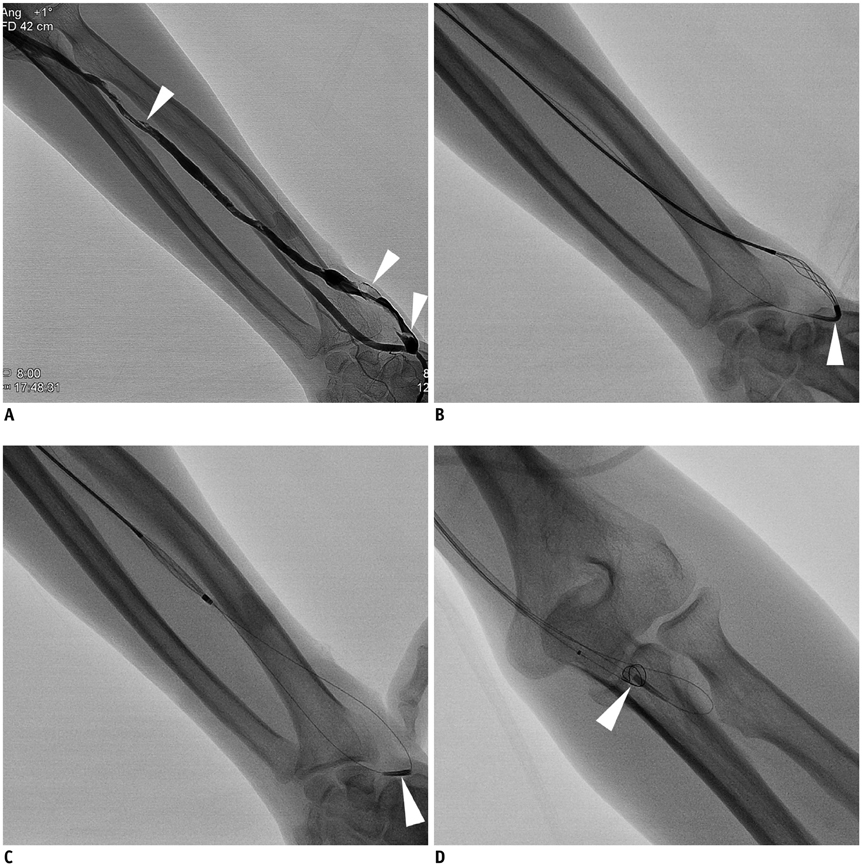Korean J Radiol.
2014 Apr;15(2):254-257. 10.3348/kjr.2014.15.2.254.
Disconnection of the Rubber Tip of Arrow-Trerotola Percutaneous Thrombolytic Device
- Affiliations
-
- 1Department of Radiology, Kangnam Sacred Heart Hospital, Hallym University College of Medicine, Seoul 150-950, Korea.
- 2Department of Radiology, Seoul National University Hospital, Seoul 110-744, Korea. angiointervention@gmail.com
- 3Department of Radiology, Korea University Medical Center, Korea University College of Medicine, Seoul 136-705, Korea.
- KMID: 1705581
- DOI: http://doi.org/10.3348/kjr.2014.15.2.254
Abstract
- A rubber tip disconnection of Arrow-Trerotola percutaneous thrombolytic device (PTD) may occur occasionally. We experienced 5 cases of a rubber tip disconnection among 453 mechanical thrombectomy sessions with the use of PTD. We present a report about these five cases and suggest possible causes for the occurrences.
MeSH Terms
Figure
Reference
-
1. Goo DE, Yang SB, Kim YJ, Moon C, Song D, Yoon SC, et al. Fogarty balloon application technique in dislodging residual thrombus on the single sheath entry point at the apex of thrombosed loop grafts. Diagn Interv Radiol. 2013; 19:150–153.2. Choi SY, Choi BG, Han KH, Chun HJ. Efficacy of a modified pharmacomechanical thrombolysis technique for endovascular treatment of thrombosed prosthetic arteriovenous grafts. Korean J Radiol. 2012; 13:300–306.3. Trerotola SO, Vesely TM, Lund GB, Soulen MC, Ehrman KO, Cardella JF. Treatment of thrombosed hemodialysis access grafts: Arrow-Trerotola percutaneous thrombolytic device versus pulse-spray thrombolysis. Arrow-Trerotola Percutaneous Thrombolytic Device Clinical Trial. Radiology. 1998; 206:403–414.4. Lazzaro CR, Trerotola SO, Shah H, Namyslowski J, Moresco K, Patel N. Modified use of the arrow-trerotola percutaneous thrombolytic device for the treatment of thrombosed hemodialysis access grafts. J Vasc Interv Radiol. 1999; 10:1025–1031.5. Shatsky JB, Berns JS, Clark TW, Kwak A, Tuite CM, Shlansky-Goldberg RD, et al. Single-center experience with the Arrow-Trerotola Percutaneous Thrombectomy Device in the management of thrombosed native dialysis fistulas. J Vasc Interv Radiol. 2005; 16:1605–1611.6. Akkus NI, Bahadur F, Varma J. Fracture of a guiding catheter in a tortuous iliac artery and its retrieval by a larger sheath. Rev Port Cardiol. 2013; 32:341–344.7. Mirza B, Vanek VW, Kupensky DT. Pinch-off syndrome: case report and collective review of the literature. Am Surg. 2004; 70:635–644.8. Koseoglu K, Parildar M, Oran I, Memis A. Retrieval of intravascular foreign bodies with goose neck snare. Eur J Radiol. 2004; 49:281–285.9. Seong CK, Kim YJ, Chung JW, Kim SH, Han JK, Kim HB, et al. Tubular foreign body or stent: safe retrieval or repositioning using the coaxial snare technique. Korean J Radiol. 2002; 3:30–37.10. Önal B, Coşkun B, Karabulut R, Ilgıt ET, Türkyilmaz Z, Sönmez K. Interventional radiological retrieval of embolized vascular access device fragments. Diagn Interv Radiol. 2012; 18:87–91.
- Full Text Links
- Actions
-
Cited
- CITED
-
- Close
- Share
- Similar articles
-
- Treatment of pulmonary thromboembolism using Arrow-Trerotola percutaneous thrombolytic device
- A Case of Mechanical Thrombolysis of Thrombosed Native Hemodialysis Fistula Using Arrow Trerotola Percutaneous Thrombolytic Device
- Blockage of Spinal Needle Hole by a Foreign Body: A case report
- Disconnection and Migration of Totally Implanted Vascular Access Devices in Three Pediatric Oncology Patients
- Dimensional stability and wettability of rubber impression materials


